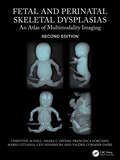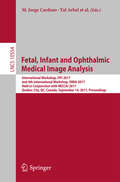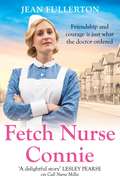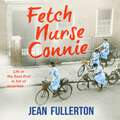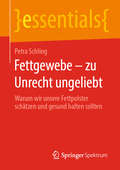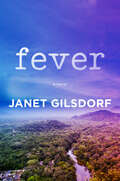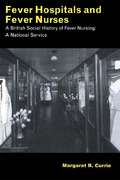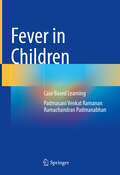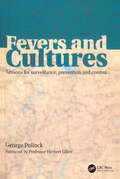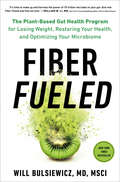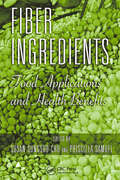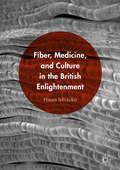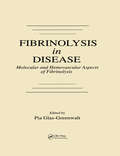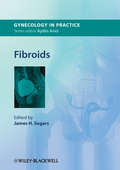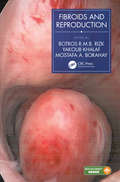- Table View
- List View
Fetal and Neonatal Lung Development: Clinical Correlates and Technologies for the Future
by Alan H. Jobe Jeffrey A. Whitsett Steven H. AbmanLung disease affects more than 600 million people worldwide. While some of these lung diseases have an obvious developmental component, there is growing appreciation that processes and pathways critical for normal lung development are also important for postnatal tissue homeostasis and are dysregulated in lung disease. This book provides an authoritative review of fetal and neonatal lung development and is designed to provide a diverse group of scientists, spanning the basic to clinical research spectrum, with the latest developments on the cellular and molecular mechanisms of normal lung development and injury-repair processes, and how they are dysregulated in disease. The book covers genetics, omics, and systems biology as well as new imaging techniques that are transforming studies of lung development. The reader will learn where the field of lung development has been, where it is presently, and where it is going in order to improve outcomes for patients with common and rare lung diseases. Provides an authoritative review of fetal and neonatal lung development. Designed to provide a diverse group of scientists with the latest developments on the cellular and molecular mechanisms of normal lung development and injury-repair processes. Covers genetics, omics, and systems biology as well as new imaging techniques that are transforming studies of lung development.
Fetal and Perinatal Skeletal Dysplasias: An Atlas of Multimodality Imaging
by Christine M Hall Amaka C Offiah Francesca Forzano Mario Lituania Gen Nishimura Valerie Cormier-DaireThis atlas is intended to give obstetricians, paediatricians, neonatologists, radiologists, molecular and clinical geneticists and anatomo-pathologists, a thorough insight into conditions (and variants) of skeletal dysplasias. Clinical and imaging findings are properly illustrated, enriched by updated genetic information. This acclaimed text returns in a revised form, with updated material, particularly on the new knowledge surrounding the genetic basis and mechanism for the various skeletal dysplasias. No clinician dealing with fetal or neonatal skeletal diagnosis or treatment will want to be without access to the wealth of illustrations and detail condensed here. Presents a clear and consistent rubric for approaching approximately 150 types of skeletal dysplasias Meets the needs of clinical gynaecologists, obstetricians, paediatricians, radiologists and geneticists Offers an essential, concise resource for the diagnosis of skeletal dysplasias which present prenatally and perinatally
Fetal and Perinatal Skeletal Dysplasias: an Atlas of Multimodality Imaging
by Christine M Hall Amaka C Offiah Francesca Forzano Mario Lituania Michelle Fink Deborah KrakowSkeletal dysplasias are rare, they may be genetic, sporadic or environmentally determined conditions, affecting bone and cartilage growth and development. The genetic mutations continue to exert their influence throughout the life of the affected individual. This unique, full colour atlas features 132 conditions with 2300 images of over 500 patients. It brings together the wide-ranging clinical disciplines involved in pre and postnatal care and diagnosis and presents perinatal images of rare skeletal disorders to include skeletal dysplasias and malformation syndromes on a case-by-case basis. It presents the most up-to-date information on the individual conditions to include the mode of inheritance (autosomal dominant or recessive, or non-genetic), the Mendelian Inheritance in Man number (MIM) for further reference reading, the locus (the chromosome number and position on the affected chromosome), the mutated gene and the affected protein. Each condition has a brief summary including synonyms, incidence, genetics, age at presentation, clinical, prenatal ultrasound and postnatal radiological features, bone histology, prognosis and differential diagnosis. Images are presented with each case illustrating different imaging modalities and with gross and/or histopathology findings. Brief clinical findings are also given where available. It is of great value to all clinicians and technicians working in fetal medicine and neonatal care. It greatly assists in diagnostic accuracy and provides clinicians and affected families with the information needed to make informed management decisions.
Fetal, Infant and Ophthalmic Medical Image Analysis: International Workshop, FIFI 2017, and 4th International Workshop, OMIA 2017, Held in Conjunction with MICCAI 2017, Québec City, QC, Canada, September 14, Proceedings (Lecture Notes in Computer Science #10554)
by M. Jorge Cardoso, Tal Arbel, Andrew Melbourne, Hrvoje Bogunovic, Pim Moeskops, Xinjian Chen, Ernst Schwartz, Mona Garvin, Emma Robinson, Emanuele Trucco, Michael Ebner, Yanwu Xu, Antonios Makropoulos, Adrien Desjardin and Tom VercauterenThis book constitutes the refereed joint proceedings of the International Workshop on Fetal and Infant Image Analysis, FIFI 2017, and the 6th International Workshop on Ophthalmic Medical Image Analysis, OMIA 2017, held in conjunction with the 20th International Conference on Medical Imaging and Computer-Assisted Intervention, MICCAI 2017, in Québec City, QC, Canada, in September 2017. The 8 full papers presented at FIFI 2017 and the 20 full papers presented at OMIA 2017 were carefully reviewed and selected. The FIFI papers feature research on advanced image analysis approaches focused on the analysis of growth and development in the fetal, infant and paediatric period. The OMIA papers cover various topics in the field of ophthalmic image analysis.
Fetch Nurse Connie
by Jean FullertonLondon, 1945 and as the end of the war is declared and the troops start returning home, the nurses of the East End are joining in the celebrations.For Nurse Connie Byrne the end of the war signals the beginning of a new chapter and as the revelries go on around the city, Connie's mind is on another celebration that she'll be able to arrange - the wedding to her sweetheart, Charlie, set to take place as soon as he arrives home. But when Connie meets Charlie off the train at London Bridge, she finds that his homecoming isn't quite going to go according to plan... Connie's busy professional life, and the larger-than-life patients in the district, offer a welcome distraction, but for how long? If nursing in the East End has taught Connie anything, it's that life is full of surprises...A heart-warming family saga, perfect for fans of Nadine Dorries and Annie Groves.
Fetch Nurse Connie (Nurse Millie and Connie #4)
by Jean FullertonLondon, 1945 and as the end of the war is declared and the troops start returning home, the nurses of the East End are joining in the celebrations.For Nurse Connie Byrne the end of the war signals the beginning of a new chapter and as the revelries go on around the city, Connie's mind is on another celebration that she'll be able to arrange - the wedding to her sweetheart, Charlie, set to take place as soon as he arrives home. But when Connie meets Charlie off the train at London Bridge, she finds that his homecoming isn't quite going to go according to plan... Connie's busy professional life, and the larger-than-life patients in the district, offer a welcome distraction, but for how long? If nursing in the East End has taught Connie anything, it's that life is full of surprises...A heart-warming family saga, perfect for fans of Nadine Dorries and Annie Groves.
Fetch Nurse Connie (Nurse Millie and Connie #4)
by Jean FullertonConnie Byrne, a nurse in London's East End working alongside Millie Sullivan from Call Nurse Millie, is planning her wedding to Charlie Ross, set to take place as soon as he returns from the war. But when she meets him off the train at London Bridge, she finds that his homecoming isn't going to go according to plan. Connie's busy professional life, and the larger-than-life patients in the district, offer a welcome distraction, but for how long?Read by Julie Maisey(p) 2015 Magna Large Print Books
Fettgewebe – zu Unrecht ungeliebt: Warum wir unsere Fettpolster schätzen und gesund halten sollten (essentials)
by Petra SchlingSo wie die Feuerwehr nicht schuld ist am verheerenden Großbrand, so ist unser Fettgewebe nicht schuld an Diabetes und Herzinfarkt. Nur wenn wir unser Fettgewebe verstehen, können wir sein Potenzial erhalten und nutzen. Petra Schling gibt in diesem essential einen Überblick über Aufbau und Funktionen unseres Fettgewebes und stellt die wichtigsten Botenstoffe von Fettzellen und ihren Vorläufen vor. Darüber hinaus klärt die Autorin Irrtümer und Missverständnisse auf, die sich um das Fettgewebe ranken. Sie erläutert eine mögliche Kausalkette vom Überfluss zum Diabetes und warum das Fettgewebe zu Unrecht zum Sündenbock gemacht wird.
Fever
by Janet GilsdorfFrom acclaimed author and Professor Emerita of Pediatrics and Epidemiology Janet Gilsdorf comes a captivating and timely novel about a young doctor's quest to uncover the cause of a mysterious disease killing young children, and the race to find a cure.In 1984, in the small Brazilian village of Promissão, a young child begins to fuss, her eyes turning pink and her skin flushed with heat. Four days later, she's dead.Sidonie Royal, an accomplished physician and scientist, arrives in the small Brazilian village of Promissão to investigate and hopefully cure this insidious new disease. With several young children already dead, and more getting sick by the day, the stakes cannot get any higher.But Sid's personal life is also in flux, as she struggles to balance a complicated relationship with her boyfriend, Paul, pressure to start a family from her well-meaning mother, conflict with her surly but brilliant coworker named Eliot, and a budding romantic attraction to her doctoral student's twin brother. As Sid relentlessly pursues an explanation for the disease, the village's physician calls in the Global Health Agency, triggering a scientific race that spans two continents and becomes increasingly defined by personal stakes.Set against the backdrop of the early days of the AIDS epidemic, Fever is about finding courage in the face of the unknown, the lasting power of community, and one woman's challenge to prove herself as she aims to make a life-saving—and career-defining—discovery.
Fever Hospitals and Fever Nurses: A British Social History of Fever Nurses: A National Service
by Margaret CurrieThis well researched book provides an interesting study of the development of fever hospitals and fever nursing, mainly in nineteenth and twentieth century Britain. It provides new insights into the development of nursing roles and nurse education and looks at the lives of key figures at that time. The text examines how this once important branch of the nursing profession emerged in the nineteenth century, only to be discarded in the second half of the following century. Drawing on the work of Goffman and Foucault, the study shows how, aided by medical advances, fever nurses transformed their custodial duties into a therapeutic role and how training schemes were implemented to improve the recruitment and retention of nurses. As standards of living improved and patient’s chances of recovery increased, many fever hospitals became redundant and fever nurses were no longer required. The wisdom of creating fever hospitals and then disbanding them is questioned in the light of changing disease patterns, international travel and the threat posed by biological warfare.
Fever in Children: Case Based Learning
by Padmasani Venkat Ramanan Ramachandran PadmanabhanFever is one of the most common presenting complaints in Pediatric practice. It can be a cause of concern to parents and the treating Pediatrician. This book describes a practical, case-based approach to diagnosing the cause of fever. The presentation simulates everyday challenges in the outpatient clinic and in-patient ward rounds, taking the learner systematically through the process of targeted history and focused clinical examination, which should result in making a provisional clinical diagnosis. A discussion on possible differentials, rational use of investigations, interpretation of lab reports, and treatment follows this. One of the unique features of this book is the initial note on parental counseling in challenging situations. The chapters provide a system-wise syndromic approach to diagnosing infections through case vignettes. It also includes cases with multisystem involvement and explanations of when to suspect non-infectious causes. This book will be of immense use to Pediatric postgraduate trainees and practicing Pediatricians. It covers pitfalls in diagnosis, atypical presentations, complications of common illnesses, causes of failure to respond to treatment, and common fallacies in interpreting lab results. The recent advances and the use of diagnostic facilities are explained.
Fever of Unknown Origin (Infectious Disease and Therapy)
by Burke A. Cunhaabout the bookAssisting clinicians in the differential diagnosis of the wide range of disorders responsible for fever of unknown origin (FUO), this source stands as the only recent and comprehensive differential diagnosis of these conditions. This guide providing a clear overview of diagnostic approaches and offers expert recommendations t
Fevered Lives: Tuberculosis in American Culture since 1870
by Katherine OttFevered Lives underscores the shifting meanings of consumption/tuberculosis in an extraordinarily readable cultural history.
Fevered Measures: Public Health and Race at the Texas-Mexico Border, 1848-1942
by John Mckiernan-GonzalezIn this book, the author examines public health campaigns along the Texas-Mexico border between 1848 and 1942 and reveals the changing medical and political frameworks U.S. health authorities used when facing the threat of epidemic disease. The medical borders created by these officials changed with each contagion and sometimes varied from the existing national borders. Federal officers sought to distinguish Mexican citizens from U.S. citizens, a process troubled by the deeply interconnected nature of border communities. The author uncovers forgotten or ignored cases in which Mexicans, Mexican Americans, African Americans, and other groups were subject to--and sometimes agents of--quarantines, inspections, detentions, and forced-treatment regimens. These cases illustrate the ways that medical encounters shaped border identities before and after the Mexican Revolution. The author also maintains that the threat of disease provided a venue to destabilize identity at the border, enacted processes of racialization, and re-legitimized the power of U.S. policymakers. He demonstrates how this complex history continues to shape and frame contemporary perceptions of the Latino body today.
Fevers and Cultures: Lessons for Surveillance, Prevention and Control
by George PollockThis book compares the methods of surveillance, prevention and control of communicable diseases in countries selected for their different situations and approaches. Based on a comprehensive study including local interviews with key individuals, supported by relevant reports and documents, it highlights the strengths and weaknesses of different approaches and suggests practical improvements for change. Consultants, public health professionals, nurses and support staff with an interest in communicable disease control will find this book to be valuable reading.
Fevers, Feuds, and Diamonds: Ebola and the Ravages of History
by Paul Farmer“Paul Farmer brings his considerable intellect, empathy, and expertise to bear in this powerful and deeply researched account of the Ebola outbreak that struck West Africa in 2014. It is hard to imagine a more timely or important book.” —Bill and Melinda Gates"[The] history is as powerfully conveyed as it is tragic . . . Illuminating . . . Invaluable." —Steven Johnson, The New York Times Book ReviewIn 2014, Sierra Leone, Liberia, and Guinea suffered the worst epidemic of Ebola in history. The brutal virus spread rapidly through a clinical desert where basic health-care facilities were few and far between. Causing severe loss of life and economic disruption, the Ebola crisis was a major tragedy of modern medicine. But why did it happen, and what can we learn from it? Paul Farmer, the internationally renowned doctor and anthropologist, experienced the Ebola outbreak firsthand—Partners in Health, the organization he founded, was among the international responders. In Fevers, Feuds, and Diamonds, he offers the first substantive account of this frightening, fast-moving episode and its implications. In vibrant prose, Farmer tells the harrowing stories of Ebola victims while showing why the medical response was slow and insufficient. Rebutting misleading claims about the origins of Ebola and why it spread so rapidly, he traces West Africa’s chronic health failures back to centuries of exploitation and injustice. Under formal colonial rule, disease containment was a priority but care was not – and the region’s health care woes worsened, with devastating consequences that Farmer traces up to the present. This thorough and hopeful narrative is a definitive work of reportage, history, and advocacy, and a crucial intervention in public-health discussions around the world.
Fiber Fueled: The Plant-Based Gut Health Program for Losing Weight, Restoring Your Health, and Optimizing Your Microbiome
by Will BulsiewiczA bold new plant-based plan that challenges popular keto and paleo diets, from an award-winning gastroenterologist.The benefits of restrictive diets like paleo and keto have been touted for more than a decade, but as renowned gastroenterologist Dr. Will Bulsiewicz, or "Dr. B," illuminates in this groundbreaking book, the explosion of studies on the microbiome makes it abundantly clear that elimination diets are in fact hazardous to our health. What studies clearly now show--and what Dr. B preaches with his patients--is that gut health is the key to boosting our metabolism, balancing our hormones, and taming the inflammation that causes a host of diseases. And the scientifically proven way to fuel our guts is with dietary fiber from an abundant variety of colorful plants.Forget about the fiber your grandmother used to take--the cutting-edge science on fiber is incredibly exciting. As Dr. B explains, fiber energizes our gut microbes to create powerhouse postbiotics called short-chain fatty acids (SCFAs) that are essential to our health. SCFAs are scientifically proven to promote weight loss, repair leaky gut, strengthen the microbiome, optimize the immune system, reduce food sensitivities, lower cholesterol, reverse type 2 diabetes, improve brain function, and even prevent cancer. Restrictive fad diets starve the gut of the critical fiber we need, weaken the microbes, and make our system vulnerable.As a former junk-food junkie, Dr. B knows firsthand the power of fiber to dramatically transform our health. The good news is that our guts can be trained. Fiber-rich, real foods--with fruits, vegetables, whole grains, seeds, nuts, and legumes--start working quickly and maintain your long-term health, promote weight loss, and allow you to thrive and feel great from the inside out. With a 28-day jumpstart program with menus and more than 65 recipes, along with essential advice on food sensitivities, Fiber Fueled offers the blueprint to start turbocharging your gut for lifelong health today.
Fiber Ingredients: Food Applications and Health Benefits
by Susan Sungsoo Cho Priscilla SamuelThis book summarizes available fiber sources and how they can be incorporated into new food products to provide improved health benefits. It rigorously examines health claims, recent research, and contradictory data; covers fiber for weight and glycemic control, and intestinal regularity; and discusses how food producers can find fiber sources and
Fiber, Medicine, and Culture in the British Enlightenment
by Hisao IshizukaThis book provides a full account of the concept of fiber and fiber theory in eighteenth-century British medicine. It explores the pivotal role fiber played as a defining, underlying concept in anatomy, physiology, pathology, therapeutics, psychology, and the life sciences. With the gradual demise of ancient humoralism, the solid fibers appeared on the medical scene both as the basic building unit of the body and as a dynamic agent of life. As such, fiber stands at the heart of eighteenth-century medicine, both iatromechanism and iatro-vitalism. Touching on the cultural aspects of fiber, the Baroque, and the culture of sensibility, this book also challenges the widely held assumption that the eighteenth century was the age of the nerve and instead offers an alternative model of fiber.
Fibrinolysis in Disease - The Malignant Process, Interventions in Thrombogenic Mechanisms, and Novel Treatment Modalities, Volume 2
by Pia Glas-GreenwaltFibrinolysis in Disease reviews the state of the art of basic and clinical aspects of the fibrinolytic enzyme system. The text, authored by outstanding and internationally known investigators, is presented in two books.The Malignant Process, Interventions in Thrombogenic Mechanisms, and Novel Treatment Modalities discusses the molecular biology of the system's key components and their fundamental roles in a variety of thrombotic and metabolic disorders. Molecular and Hemovascular Aspects of Fybrinolysis presents the latest findings and concepts of the association between plasminogen activator (u-PA) overexpression and abnormal growth regulation in a variety of solid tumors and in leukemia. One chapter deals with various successful interventions in thrombogenic mechanisms, ranging from exercise and diet to anticoagulants and direct and indirect thrombolytic agents. It concludes with a projection of exciting, novel treatment modalities in thrombotic and malignant diseases.
Fibrinolytic Bacterial Enzymes with Thrombolytic Activity
by Essam KotbStress, high blood pressure, smoking, pollution, fast foods, overweight, excessive travelling, surgery, less movement are common features in our modern life. These features are risky for blood clotting disorders. According to WHO, over 29% of the total mortalities worldwide are due to thrombosis. By the year, 2020 cardiovascular diseases (CVDs) may cause an estimated 25 million deaths per year, thus antithrombotic therapy is of great interest. The available thrombolytic agents such as urokinase are highly expensive, antigenic, quite unspecific, pyretogenic and hemorrhagenic. Therefore, the production of fibrinolysing enzymes, which rapidly dissolute thrombi within the vascular tree, without the detriments by microorganisms, as described in this book, is the desirable aim of today's research.
Fibrocystic Diseases of the Liver
by Karen F. Murray Anne M. LarsonIn recent years there have been huge advances in the understanding of the genetic and molecular basis of the fibrocystic diseases. This volume provides a thorough review of fibrocyctic diseases that affect the liver. It contains in-depth discussions of the genetics, molecular biology, pathogenesis, histology, clinical presentations, complications of, treatment, and prognosis of the conditions affecting children and adults, and hence will be the gold-standard reference for these conditions. In addition, the histological features that distinguish these conditions from other potentially fibrosing hepatopathies are illustrated. Conditions with syndromic features involving the kidney or other organ systems are also reviewed. Thorough review of the clinical phenotypes, their presentations, treatment, potential complications of, and prognosis is discussed. Fibrocystic Diseases of the Liver will be an invaluable resource for hepatologists, gastroenterologists, nephrologists, and hepatic surgeons who care for children and adults with liver disease, as well as basic scientists in molecular genetics, hepatobiliary pathophysiology, hepatology and nephrology.
Fibroid Uterus: Surgical Challenges in Minimal Access Surgery
by Rooma Sinha Kurian Joseph Arnold P. AdvinculaThis book on fibroid uterus focuses on surgical challenges in minimal access surgery that a surgeon faces while treating this condition. This book explores the role of various imaging modalities in both diagnosis and planning of the treatment. Various surgical techniques, such as hysteroscopy, laparoscopy, and robotic are discussed which will help readers to understand the pros and cons of each one. Teaching practical tips from experts regarding these procedures, the book aims to help surgeons make clinical decisions while they choose surgical procedures for their patients in various clinical settings. The book highlights both the conservative (techniques of myomectomy) and hysterectomy by various methods for treating fibroids. Key Features How to use various imaging modalities for preoperative evaluation of fibroids Issues in preoperative counseling and consent before surgery for fibroids Overview of surgical treatment of fibroids Individual chapters on practical tips by experts for various surgical techniques used for both myomectomy and hysterectomy Discusses the controversy in morcellation and how to perform it safely Covers the problem of parasitic fibroids that have increased in recent times Discusses issues like breach in endometrial cavity during myomectomy, surgery for adenomyosis, uterine rupture and recurrence after myomectomy When to call it a day and convert from laparoscopy to laparotomy
Fibroids (GIP - Gynaecology in Practice)
by James H. SegarsFibroids are benign growths of the uterus. They are the most common tumours found in women (20-30% of women), usually in later reproductive years. This book covers evidence-based indications for treatment of uterine fibroids in gynecology, the management of fibroids in pregnancy, surgical treatments and outcomes, rare fibroid syndromes, and more.
Fibroids and Reproduction
by Botros R.M.B. Rizk, Yakoub Khalaf and Mostafa A. BorahayThe most common abnormal growth of the female reproductive system, fibroids, are thought to affect the majority of women at some point during their reproductive years. This text from leading fibroid experts looks at the latest evidence on how the problem impinges on reproduction and the most up-to-date management and treatment options available to help patients with fibroids hoping to conceive. Print versions of this book also include access to the eBook version with links to procedural videos.

